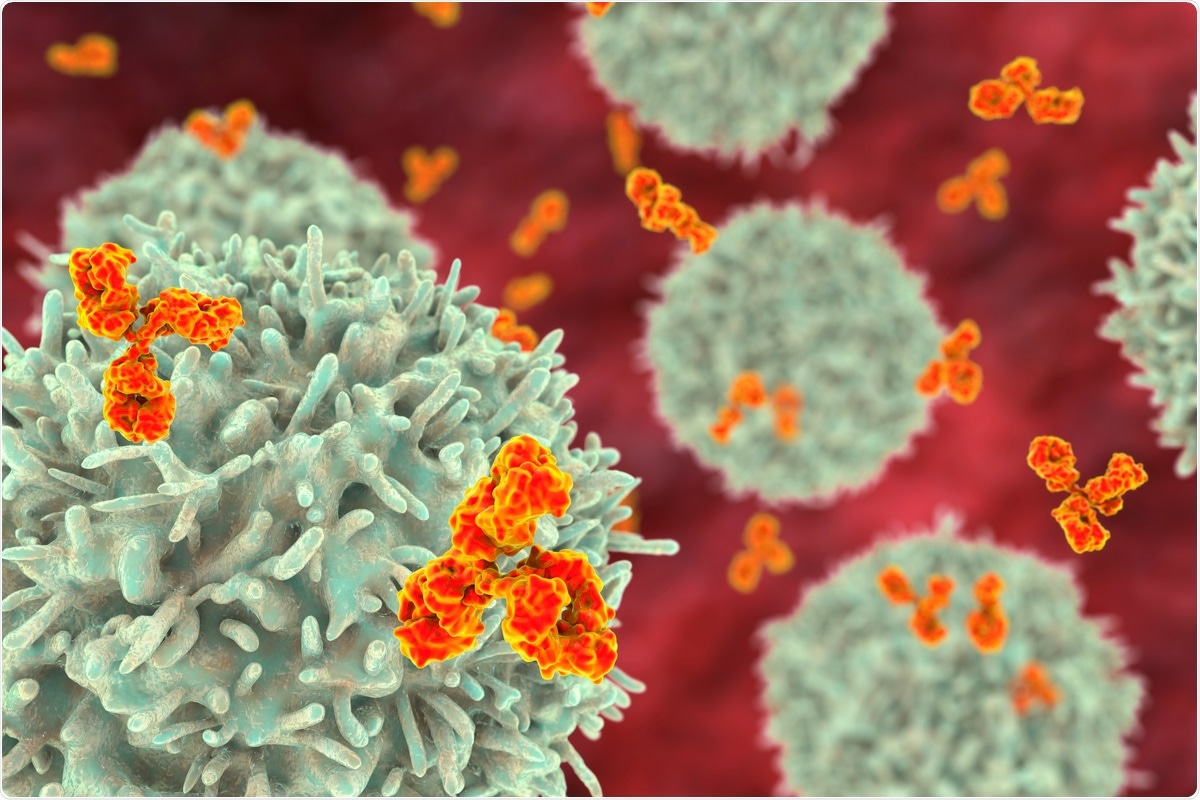Home » Health News »
No evidence of pre-existing antibody and B cell immunity against SARS-CoV-2 in unexposed adults
Following several studies over the past year that observed T cells gathered before the pandemic show reactivity against both the spike and nucleocapsid proteins of severe acute respiratory syndrome coronavirus 2 (SARS-Cov-2) and several non-structural proteins. Most of the T cell's response was detected against spike proteins similar to those seen in coronaviruses known to cause the common cold. It is hypothesized that T cell immunity is likely to have originated from exposure to these viruses. A group of researchers from the University Of Cologne investigated a similar phenomenon in B cells in a study available on the preprint server bioRxiv*.
 Study: No substantial pre-existing B cell immunity against SARS-CoV-2 in healthy adults. Image Credit: Kateryna Kon/ Shutterstock
Study: No substantial pre-existing B cell immunity against SARS-CoV-2 in healthy adults. Image Credit: Kateryna Kon/ Shutterstock
A preprint version of the study is available on the bioRxiv* server while the article undergoes peer review.
The study
The scientists gathered plasma samples, B cells, and monoclonal antibodies from 150 individuals that had not been exposed to SARS-CoV-2. These came from individuals with a wide range of ages (18-66) and roughly half from female and male donors. When investigating the plasma samples, they initially tested for binding to the full spike ectodomain, or the S1 subunit, as well as performing several ELISA assays. Binding activity against the full spike protein was also assessed. Very little IgG, IgM, or IgA binding was seen in these assays. Several samples showed binding in one assay, but unfortunately, this could not be confirmed by flow cytometry. While some samples showed notable neutralization activity against a SARS-CoV-2 pseudovirus, very little was seen against wild type.
The same trend was seen when analyzing reactivity against SARS-CoV-2 in B cells from pre-pandemic samples. By using the same analysis gate in B cell sorting for previously infected individuals and 40 donations made before the pandemic, the scientists could identify the frequency of reactive B cells in both groups. The pre-pandemic samples showed reactive IgG – B cells at a frequency between 0 and 0.0016%, with a median of 0.0001%, compared to 0.007 to 0.39% in the exposed individual's group. After adjusting the sorting gate to account for reactive B cells present in individuals unexposed to SARS-CoV-2 that may not be present in exposed individuals, very similar results occurred.
Following this, the researchers produced 158 monoclonal antibodies (IgM- and IgG derived) from 200 candidates gathered from pre-pandemic samples. None showed any binding activity to the SARS-CoV-2 spike protein or any neutralization of the SARS-CoV-2 pseudovirus.
Some of the most interesting results in the study occurred when the scientists performed next-generation sequencing on healthy individuals and analyzed the result to identify heavy and light chain regions of B cells that resembled similar regions in antibodies known to be effective against the disease. To test whether these near-homologous regions showed reactivity against SARS-CoV-2, they created chimeras using either a light chain from a non-exposed B cell and a heavy chain from a known reactive monoclonal antibody, or vice versa. They found that all pre-pandemic light chains paired with an effective heavy chain retained binding and neutralization effectivity, while only 3/23 chimeras with a pre-pandemic heavy chain were effective.
While the vast majority of the results suggest no pre-pandemic B cell immunity from exposure to endemic coronaviruses, the investigation into heavy and light chains suggests that some naïve B cells can replace original chains in reactive antibodies without reducing their functionality to fight the disease. This could suggest a capacity for rare naïve B cells to develop the ability to react to SARS-CoV-2.
Several previous studies analyzing the plasma of both pre-pandemic and exposed individuals do provide some contrasting results. However, the authors argue that these studies only investigate plasma/serum, do not analyze the B cell precursors or memory cells, and could miss some of the insights seen by this level of inspection. Alternatively, these studies have observed reactivity against SARS-CoV-2 in groups such as children and pregnant women. The researchers conclude that their data shows that a large population of healthy adults is unlikely to show any B cell reactivity to SARS-CoV-2.
*Important notice
bioRxiv publishes preliminary scientific reports that are not peer-reviewed and, therefore, should not be regarded as conclusive, guide clinical practice/health-related behavior, or treated as established information.
- Ercanoglu, M., et al. (2021) No substantial pre-existing B cell immunity against SARS-CoV-2 in 2 healthy adults. bioRxiv preprint server. https://doi.org/10.1101/2021.09.08.459398 https://www.biorxiv.org/content/10.1101/2021.09.08.459398v1.full.pdf
Posted in: Medical Science News | Medical Research News | Disease/Infection News
Tags: Antibodies, Antibody, Assay, B Cell, Cell, Cell Sorting, Children, Cold, Common Cold, Coronavirus, Coronavirus Disease COVID-19, Cytometry, Flow Cytometry, Frequency, Homologous, immunity, Monoclonal Antibody, Pandemic, Protein, Pseudovirus, Respiratory, SARS, SARS-CoV-2, Severe Acute Respiratory, Severe Acute Respiratory Syndrome, Spike Protein, Syndrome

Written by
Sam Hancock
Sam completed his MSci in Genetics at the University of Nottingham in 2019, fuelled initially by an interest in genetic ageing. As part of his degree, he also investigated the role of rnh genes in originless replication in archaea.
Source: Read Full Article



